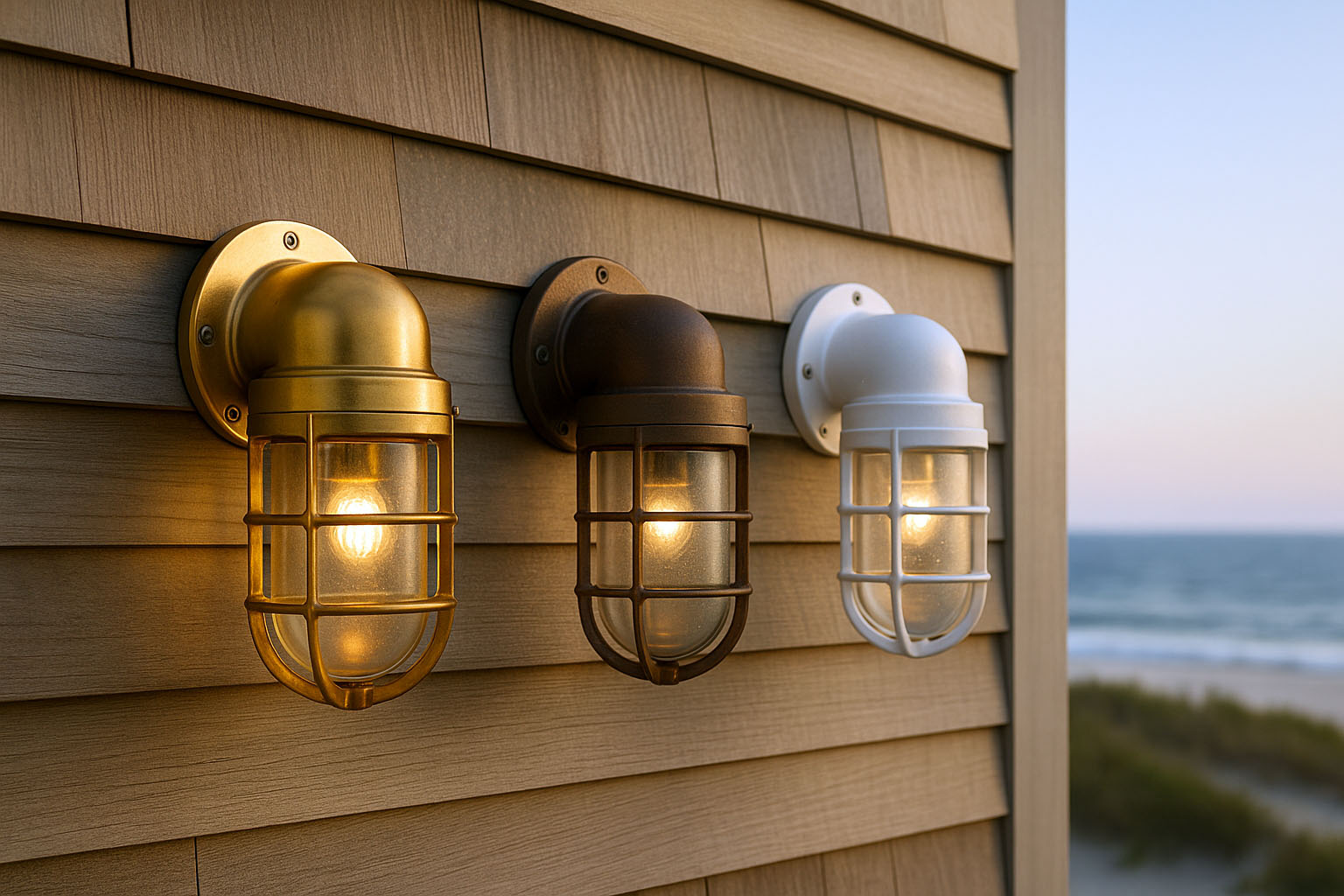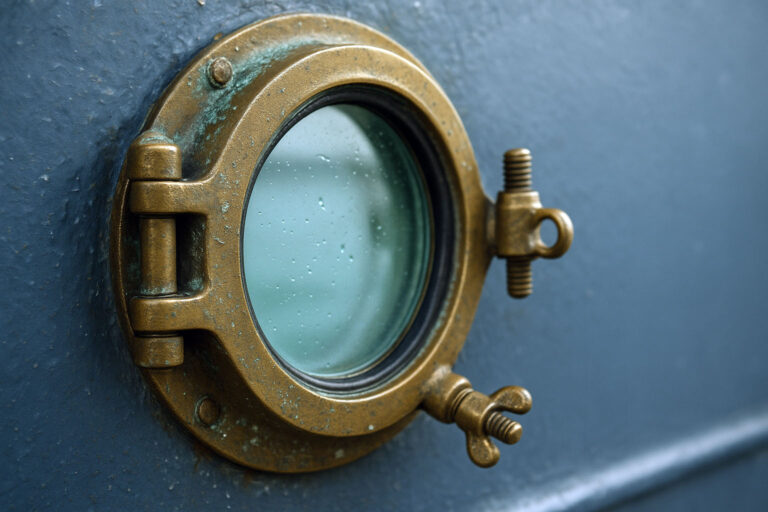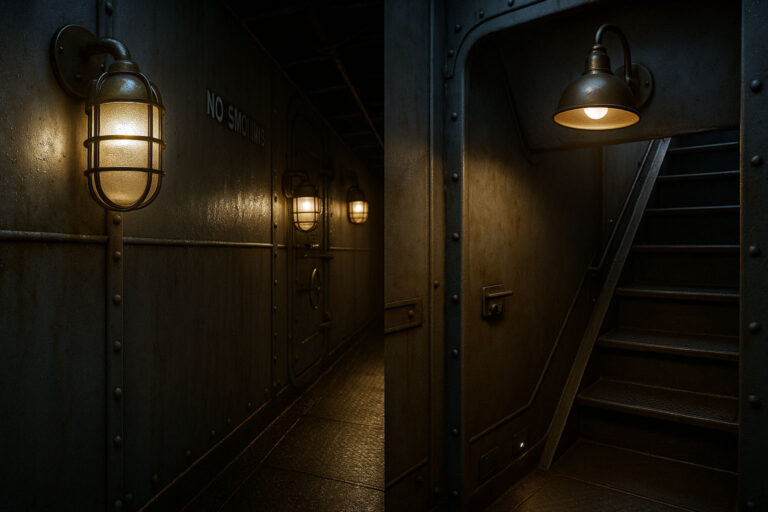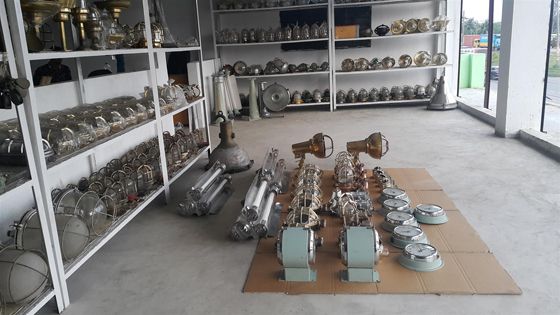Nautical Light Materials: Brass vs Bronze vs Aluminum for Coastal Homes
Choosing the right metal for nautical lights isn’t just about style; on the coast, it decides how long your fixtures survive. Salt air, wind, and sun punish porch sconces, bulkhead lights, and dock fixtures every single day. Brass, bronze, and aluminum all show up on classic ship lights and modern beach houses, but they behave differently. I restore and sell these from ship-breaking yards, and the right pick saves money and hassle. This guide keeps it simple: what each metal is, why it matters, the pros and cons, and step-by-step advice for buying, installing, and maintaining lights near the water.
TL;DR
Bronze wins for surf-side homes and docks. Brass delivers the classic warm look with solid durability under covered areas. Aluminum is the lightweight, budget pick only when it’s marine-grade and coated. Within 0–5 miles (0–8 km) of ocean? Choose bronze first.
What Each Metal Is
Brass (copper + zinc)
Brass is copper mixed with zinc; “naval brass” adds a bit of tin for seawater resistance. It casts cleanly, threads well, and takes a mirror polish. Solid brass ages to a warm brown patina. Cheap plated steel in “brass color” is not brass; it rusts fast outdoors.
Bronze (copper + tin)
Bronze—especially silicon bronze—handles salt water better than most brasses. It’s tougher, a touch heavier, and develops a deep brown to espresso patina, sometimes green over years. Classic ship hardware and prop nuts are bronze for a reason: strength, thread integrity, and long life in splash zones.
Aluminum (lightweight alloy)
Aluminum forms a protective oxide skin, but in salt air it needs help: anodizing or a quality powder coat over etched, pre-treated metal. Marine grades like 5052 or 6061 work well when isolated from steel. It’s light, affordable, and modern, but exposed raw aluminum pits near the ocean.
Why Coastal Conditions Matter
Coastal air carries salt crystals that dissolve into an electrolyte, speeding corrosion and galvanic reactions between dissimilar metals. Wind drives spray into seams; UV cooks coatings; sand acts like sandpaper. Result: peeling finishes, seized screws, chalking paint, and pitted housings. Closer to surf equals faster failure. Covered porches fare better than open decks; bays are kinder than oceanfront. Your metal choice sets your maintenance calendar and the look over time: glossy and high-touch, or hands-off patina. Also consider weight: heavy castings need solid anchors; lightweight fixtures suit thin siding and high mounts. Electrical safety matters too: corrosion can creep into sockets and grounds.
See more: Nautical lighting fixtures
Benefits and Drawbacks
Brass — pros and cons
- Benefits: Warm color, classic nautical vibe, easy to polish, plentiful vintage supply, and typically repairable with new gaskets and glass. Threads cut cleanly; castings feel substantial (4–6 lb / 1.8–2.7 kg for mid-size).
- Drawbacks: Some brasses dezincify in daily salt; lacquer needs redoing; fingerprints show when polished. Avoid “brass-plated” steel—rust will bleed through. Use 316 stainless or silicon-bronze screws to prevent staining and stuck fasteners. Covered areas extend life significantly.
Bronze — pros and cons
- Benefits: Best corrosion resistance of the three, excellent strength, forgiving patina that hides wear, and low maintenance near surf. Silicon bronze hardware matches chemically, reducing galvanic issues. Ideal for docks, pool enclosures, and open coastal facades.
- Drawbacks: Higher cost and weight, limited color options unless painted, and longer lead times for true cast bronze. If you want mirror shine, expect frequent waxing or accept a living finish. Installers appreciate threads.
Aluminum — pros and cons
- Benefits: Light weight, modern profiles, lowest cost, and endless colors with powder coat. Easy to mount on thin siding and high walls; fewer anchors needed.
- Drawbacks: Finish chips can creep in salt; raw edges corrode; mixing metals triggers galvanic attack. Needs marine-grade prep (etch, chromate, prime) and hardware. Keep it isolated from pressure-treated lumber, and check coatings yearly in 0–5 mile (0–8 km) salt zones. Touch up chips immediately after storms.
Where Each Works Best
- Oceanfront (0–0.5 mile / 0–0.8 km): Bronze first choice. Brass acceptable under deep cover; aluminum only if anodized or high-spec powder coated and well isolated.
- Near coast (0.5–5 miles / 0.8–8 km): Brass or bronze outdoors; aluminum okay for covered porches and upper stories.
- Docks, boathouses, and splash zones: Bronze. Seal threads, use tinned wiring, add drip loops.
- Indoor coastal bathrooms and mudrooms: Brass excels—warm tone, easy care.
- Modern beach homes seeking color: Powder-coated aluminum or painted bronze; choose UV-stable finishes.
- Rental or flip projects on a budget: Aluminum wins if the coating is reputable and hardware is stainless.
- Historic or cottage aesthetics: Solid brass passage and bulkhead lights look right and age gracefully.
How to Choose (Step-by-Step)
- Map your salt exposure: oceanfront, near-coast, or inland. Be honest about wind direction and daily spray.
- Pick the look: warm living patina (brass/bronze) or crisp painted/anodized color (aluminum/bronze).
- Check weight vs mounting: heavy castings need solid anchors or masonry; lightweight aluminum suits thin siding.
- Confirm construction: solid cast brass/bronze vs plated steel; marine-grade aluminum with anodize or powder coat.
- Hardware and isolation: 316 stainless or silicon-bronze screws, nylon washers, and EPDM gaskets; avoid mixed stacks.
- Plan maintenance: okay with occasional polishing? choose brass. Want low-touch? bronze or coated aluminum. Budget tight? prioritize aluminum but verify coating system and warranty.
Installation & Maintenance (Step-by-Step)
- Wire smart: use tinned copper leads, marine-grade heat-shrink connectors, and a drip loop.
- Seal the mount: backplate over butyl tape or an EPDM gasket; pre-drill and countersink.
- Fasteners: 316 stainless or silicon bronze. Add nylon washers to break metal-to-metal contact.
- Anti-seize: a small dab on threads prevents galling and future seizures.
- Grounding: bond metal bodies; if unsure, have an electrician check continuity.
- Finish care:
– Brass: mild polish, rinse monthly, wax if you want shine.
– Bronze: rinse, nylon brush, optional paste wax; avoid harsh acids.
– Aluminum: gentle wash; touch up chips with etch-prime + topcoat. - Storm prep: tighten globes, inspect gaskets, cut power if flooding threatens docks or boathouses.
- Annual check: remove fasteners, re-grease, inspect seals, and reapply wax or paint as needed.
Light Quality & Color Temperature
Brass and bronze amplify warm LED tones (think 2700–3000K) and look cozy at night. Aluminum reads neutral unless painted warm. For docks and pathways, use clear glass with patterned fresnel lenses to spread light without glare. Aim for sealed E26/E27 sockets, 110–240V ready.
Cost & Lifespan Snapshot
Typical medium fixtures: aluminum $70–$180, brass $150–$350, bronze $220–$500+ depending on maker and finish. Lifespan near surf: bronze decades with rinsing; brass decades under cover or with upkeep; aluminum varies—excellent if the coating stays intact, poor if it chips and isn’t touched up. Labor costs drop when you choose good hardware and anti-seize from day one.
Common Mistakes to Avoid
- Buying “brass-color” steel instead of solid brass.
- Mounting aluminum directly to pressure-treated lumber without a barrier.
- Mixing screws: zinc, 304 stainless, and brass all in one stack.
- Skipping anti-seize on threads.
- Trapping LEDs in sealed housings without ventilation.
- Ignoring rinse schedules; salt left sitting multiplies problems.
Final Recommendation
Live right on the coast? Choose bronze and forget the drama. Within five miles (eight kilometers), brass or bronze are safest; aluminum only with high-quality coatings. Want warmth and character? Go brass. Want lowest upkeep outdoors? Bronze. Tight budget and covered areas? Aluminum.







